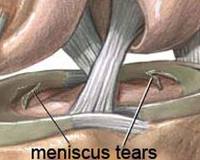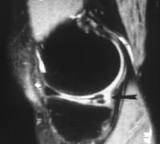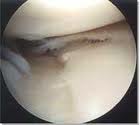Introduction
The medial and lateral meniscus of the knee are important structures to knee function. They act to better distribute weight-bearing forces and to protect the articular cartilage. They are also a common source of intra-articular knee pain and swelling when they get torn. A torn meniscus can happen at any age and be associated with other types of knee issues. They can happen from an acute injury that one may remember, or they can happen asymptomatically and only later begin to cause problems.
Anatomy
The meniscus of the knee is a semi-circular gasket-like structure made out of fibrocartilage. It functions to better mate the end of the femur which is a round bone to the top of the tibia which is a more flat bone. It helps them fit together better.
The medial and lateral meniscus pads look different. The medial side is larger, but thinner. The lateral side is smaller, but thicker and is more important in contributing to knee stability. The articular cartilage or nice smooth coating on the ends of the femur and tibia are the most important parts of the knee. The meniscus helps protect them and spread out joint forces. Studies show that loss of the meniscus concentrates force on a smaller area of the articular cartilage and can contribute the knee wearing out prematurely.
Several types of meniscus tears can occur. How they are treated and what symptoms they give often depends on the type of tear. A bucket handle tear causes more mechanical symptoms. A radial tear will often just cause pain. These are fairly complex 3 dimensional structures, and they should be preserved if at all possible.
What causes meniscus tears?
Meniscus tears can happen at any age. The meniscus tends to be less pliable and more brittle as we age. When younger patients develop a meniscus tear, it is more commonly associated with a traumatic twisting event. These also tend to be more catastrophic tears that involve more of the meniscus such as bucket handle tears. Every effort should be made to fix these if possible. Unstable knees such as those that are ACL deficient also have much higher incidence of meniscus tears.
The more common mechanism of meniscus tears in less young patients ( over 30 yrs) tend to be a squatting and turning type of injury such as getting dishes out of a lower cabinet in the kitchen or squatting in the garden. They often don’t give symptoms until later when the patient is more active. The knee will then hurt and often swell.
Symptoms
The most common problem caused by a torn meniscus is pain . The pain is often felt along the joint line where the meniscus is located or may be more vague and involve the whole knee. If the torn portion of the meniscus is large enough, locking may occur. Locking simply refers to the inability to completely straighten out the knee. Locking occurs when the fragment of torn meniscus gets caught in the knee and will not allow the leg to straighten completely. The meniscus tear also causes the knee to recurrently swell which is often felt as stiffness or tightness. This internal knee swelling is called an effusion. It is a result of irritation of the lining of the knee, or synovium, which produces the fluid. Both the pain and swelling associated with a meniscus tear can be very activity related. That is, the more active one is, the more the knee hurts and swells. The less active, the better it often feels.
There are long term effects of a torn meniscus as well. The constant rubbing of the torn meniscus on the articular cartilage may cause wear and tear on the surface, leading to degeneration of the joint. This happens more often in unstable type tears.
The are 3 common causes of symptoms of recurrent pain and swelling the knee. These are meniscus tears, loose bodies, and the presence of unstable areas of articular surface ( see video of Common Causes of Knee Swelling).
Diagnosis
It is often very clear just based upon the initial history and physical exam whether a meniscus tear is present or not. The patient may have the classic history as described above, or it may present more subtly. Patients sometimes will only complain of recurrent swelling without much pain. Regardless it is important to get these types of symptoms checked out because meniscus tears don’t go away by themselves.
Suspected meniscus tears can be confirmed by MRI scan. This painless procedure takes less than an hour and gives a three-dimensional view of the soft tissue structures in the knee. It is about 90%
accurate for meniscus tears. It is not good, however, for picking up loose bodies or areas of unstable articular cartilage. Other injuries such as ligament tears of bone bruises show up and allow a more complete picture of the patient’s underlying problem. You will find I don’t rely at all on any radiologist interpretation of these studies. I feel that don’t have the “learning curve” over the years of being able to associate MRI findings with what I have actually found at arthroscopy. I prefer to go over the MRI studies with you myself.
Arthroscopy ultimately gives a clear and complete diagnosis of the status of everything inside the knee joint including the meniscus. This outpatient surgical procedure involves a mild general anesthetic, and takes about 45 minutes. Three small poke holes are made to introduce the arthroscopy with is about the size of a ball point pen, an inflow cannula to inflate the knee with arthroscopic fluid, and a third working portal to address the meniscus tear.
Treatment Options
Video of Dr. Maffet performing arthroscopic meniscus surgery here.
Initial treatment will often depend on the severity of the symptoms. A mechanically locked knee from a bucket handle meniscus tear needs to be addressed as soon as possible. Any tear especially in younger patients that are potentially repairable also need to be addressed quickly. If a large tear is displaced for some period of time, it will often scar and plastically deform to the point it is no longer repairable.
In more routine situations, the option to the patient is usually to either 1) adjust their activity level down to what their knee lets them do without swelling and hurting, or 2) perform an arthroscopic
procedure as described above to fix the meniscus tear. In my experience, it usually doesn’t work out leaving a symptomatic meniscus tear alone for long. It will just keep causing recurrent pain and swelling until you fix it.
My goal as an arthroscopic surgeon is to preserve the meniscus as much as possible. Meniscus repairs are done when the tear is repairable. Many techniques are available to stitch the unstable meniscus back together if it occurs in the vascular peripheral portion. If the tear is not repairable, than the torn portion must be removed. As much of the meniscus is preserved as possible. It is there for a reason, however, the torn portion isn’t doing it’s job, but it rather damaging the joint. The results over the years of arthroscopic partial meniscus removal leaving the stable untorn meniscus left, have been very good.



